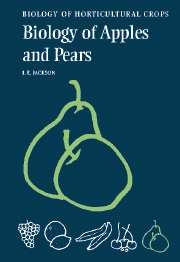Book contents
- Frontmatter
- Contents
- Preface
- Acknowledgements
- Introduction
- 1 The growing of apples and pears
- 2 Apples and pears and their relatives
- 3 Apple and pear root systems: induction, development, structure and function
- 4 The graft union, grafting and budding
- 5 Mechanisms of rootstock and interstock effects on scion vigour
- 6 The shoot system
- 7 Leaves, canopies and light interception
- 8 Photosynthesis, respiration, and carbohydrate transport, partitioning and storage
- 9 Flowers and fruits
- 10 Eating quality and its retention
- 11 Mineral nutrition
- 12 Water relations
- 13 Diseases, pests, and resistance to these
- 14 Biotechnology of apples and pears
- Cultivar Index
- General Index
- References
14 - Biotechnology of apples and pears
Published online by Cambridge University Press: 13 August 2009
- Frontmatter
- Contents
- Preface
- Acknowledgements
- Introduction
- 1 The growing of apples and pears
- 2 Apples and pears and their relatives
- 3 Apple and pear root systems: induction, development, structure and function
- 4 The graft union, grafting and budding
- 5 Mechanisms of rootstock and interstock effects on scion vigour
- 6 The shoot system
- 7 Leaves, canopies and light interception
- 8 Photosynthesis, respiration, and carbohydrate transport, partitioning and storage
- 9 Flowers and fruits
- 10 Eating quality and its retention
- 11 Mineral nutrition
- 12 Water relations
- 13 Diseases, pests, and resistance to these
- 14 Biotechnology of apples and pears
- Cultivar Index
- General Index
- References
Summary
Propagation in vitro
Propagation in vitro provides a method of rapid propagation of clonal plant material. It has a number of specific uses in the production of apple and pear plants which extend and complement the traditional means by which these, both scions and rootstocks, are vegetatively propagated. It also provides the reliable and efficient regeneration systems from somatic tissues that are essential to the development of systems of transfer of individual genes in the process of genetic engineering.
Shoot culture involves the use of explants which may be nodal buds or shoot tips ranging from 0.3 mm to 1.0 cm. Explants are surface-sterilized, usually by washing in solutions of sodium or calcium hypochlorite. They are then cultured in a medium based on that of Murashige and Skoog (1962), containing mineral salts, sucrose, cytokinin and possibly some auxin and gibberellin, and solidified with agar. Sorbitol may be more effective than sucrose with some apple cultivars and phloridzin or its breakdown product phloroglucinol may increase shoot growth (Jones, 1993). Shoot cultures are maintained on the culture medium in illuminated growth rooms. Their axillary buds extend to give new shoots which are excised at approximately monthly intervals and transferred to a fresh medium where they in turn produce axillary shoots. Shoot culture lines may be multiplied indefinitely by sequential subculture.
Shoot cultures may become slow-growing with tightly-rolled translucent leaves. This condition is known as vitrification.
- Type
- Chapter
- Information
- The Biology of Apples and Pears , pp. 473 - 482Publisher: Cambridge University PressPrint publication year: 2003



